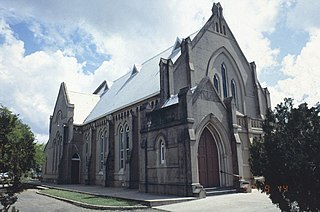Taringa is a suburb of Brisbane, Australia 5 kilometres (3.1 mi) south-west of the Brisbane CBD. Taringa is mostly residential, except for a small number of commercial buildings mostly clustered along Moggill Road. It is a popular neighbourhood among the students of the University of Queensland and the Queensland University of Technology because of its proximity to the universities and to Brisbane city.

Brisbane Boys' College (BBC) is an independent, Presbyterian and Uniting Church, day and boarding school for boys, located in Toowong, a suburb of Brisbane, Queensland, Australia.
James Birrell (1928-2019) was an architect responsible for the design of significant buildings in Queensland, Australia. James Birrell practiced from 1951 to 1986.

St Andrews Uniting Church is a heritage-listed church at 131 Creek Street, Brisbane CBD, City of Brisbane, Queensland, Australia. It was designed by George David Payne and built in 1905 by Alexander Lind & Son. Initially St Andrews Presbyterian Church, it became part of the Uniting Church following the merger of the Presbyterian, Methodist and Congregational Churches in 1977. It was added to the Queensland Heritage Register on 21 October 1992.
Maurice Hurst (1929-2003) OAM, was one of Queensland's leading architects of the Noosa style of architecture. Maurice Hurst is considered a forerunner in Australian Architecture. Having trained and worked in England, he then returned to practice his skills in both architectural design and drafting. Not only a style innovator and a conservation pioneer, Hurst acted as a staple of Queensland's domestic architecture for more than half a century. Mostly working in the Sunshine Coast and Brisbane regions, Hurst defined and shaped the area stylistically and spiritually for years.

George David Payne (1853–1916) was an Australian architect. He worked for a short time in the Public Works Department in Queensland, alongside John Smith Murdoch and Thomas Pye in a time when the Department was producing a considerable amount of high quality works. Payne's greatest achievement is undoubtedly his design of St. Andrew's Presbyterian Church, Brisbane.

Ithaca Presbyterian Church is a heritage-listed church, located at 100 Enoggera Terrace, in the inner city suburb of Paddington, Brisbane, Queensland, Australia.. The land was purchased in 1919 by the New Building Fund Committee of the Presbyterian Church, who collected £8000 for the church’s construction. The design was commissioned to leading architectural firm Wilson Architects, who were renowned members of Brisbane’s Presbyterian community. Construction commenced in 1927 and the building was formally dedicated and opened on Saturday February 9, 1929.
Rosemary Opala (1923–2008) was an Australian artist, writer and nurse, and is regarded for her work as a Queensland environmentalist, historian, social commentator and community activist.
Wilson Architects is one of Australia's the oldest architectural practices in Australia. The firm specialises in the design of educational and laboratory spaces and facilities.

Karl Langer (1903–1969) was an Austrian-born architect in Queensland, Australia. A number of his works are listed on the Queensland Heritage Register.

St Thomas' Anglican Church is a heritage-listed church at 69 High Street, Toowong, City of Brisbane, Queensland, Australia. It was designed by Francis Drummond Greville Stanley and built in 1877 by Henry Pears. It was also known as St Thomas' Church of England. It was added to the Queensland Heritage Register on 21 October 1992.

John Francis (Jack) Hennessy (1887–1955) was an Australian architect and son of architect John Francis (Jack) Hennessy, senior. Many of his works are listed on the Queensland Heritage Register.

Cliffside Apartments is a heritage-listed apartment block at 76 Lower River Terrace, Kangaroo Point, City of Brisbane, Queensland, Australia. It was built from 1936 to 1937. It is also known as Cliffiside Flats. It was added to the Queensland Heritage Register on 27 February 2004.

St Paul's Presbyterian Church is a heritage-listed church at 43 St Pauls Terrace, Spring Hill, City of Brisbane, Queensland, Australia. It was designed by Francis Drummond Greville Stanley and built from 1887 to 1889 by Thomas Rees. It was added to the Queensland Heritage Register on 21 October 1992.

St Andrew's Presbyterian Church is a heritage-listed church at 280 Bolsover Street, Rockhampton, Rockhampton Region, Queensland, Australia. It was designed by Voller & Graham built from 1893 to 1926. It was added to the Queensland Heritage Register on 21 October 1992.

St Paul's Anglican Church is a heritage-listed church at 8 Main Street, Proserpine, Whitsunday Region, Queensland, Australia. It was designed by Eddie Oribin and built from 1958 to 1959 by Les Tinsley & Co. It is also known as St Paul's Anglican Memorial Church and Proserpine Church of England. It was added to the Queensland Heritage Register on 11 October 2013.

Ronald Martin Wilson (1886–1967) was an architect and engineer in Brisbane, Queensland, Australia. A number of his works are heritage-listed.
Peter Newell (1916–2010) was an Australian architect, who worked in the modernist tradition in Queensland and became an architectural critic.
Vitaly de Gzell (1908-1977) was a Russian-Australian architect, who practised in Queensland in the modernist tradition.













